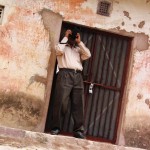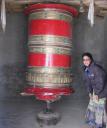
Travel India Leh – II
Enigmatic land of Sand and Snow
In the first part, I gave an overview of Leh and Ladakh.
And I took the readers on a journey east of Leh – past Shey, Thiksey, Hemis and Chemrey, over Changla Pass and on to the beautiful Pangong Lake.
In this second part, I will write about some wonderful places West of Leh.We will visit some of the oldest monasteries; the sangam (confluence) of Indus and Zanskar Rivers; the unique Magnetic Hill; and meet our furry friends – the Yak and Pashmina sheep.
I was curious to know what was the religion of Ladhak before Buddhism.
The original religion of Ladakh (and also Tibet) was Bon founded by Tönpa Shenrab or gShen-rab mi-bo (also known as Buddha Shenrab, Guru Shenrab, Tonpa Shenrab Miwoche, Lord Shenrab Miwo and other titles).
Like the Buddha Shakyamuni, Tönpa Shenrab was of royal birth.
Tönpa Shenrab left his royal inheritance at the age of 31, to follow the path of enlightenment.
Tönpa Shenrab embraced the life of a renunciate and commenced austerities, spreading the dharma in the land of Zhangzhung near what is believed to be Mount Kailash. But we have no reliable sources to establish his historicity, his dates, his racial origin, his activities, and the authenticity of the enormous number of books attributed either directly to him or believed to be his word.
The latter, the Bonpo say, were written down after his death in much the same way as the Buddhist scriptures were assembled.
No pre-10th century materials are available which could throw light on activities such as his visit to Tibet.
A new wave of Buddhism entered Ladakh when the reformist sect of the Gelugpa created by Tsongkhapa led to the reestablishment of monasteries in the 15th century.
Most of the old shrines of the earlier Bon religion were converted into Buddhist monasteries.

Lamayuru Monastery (125 Kms west of Leh)
This is the oldest and most spectacularly set monastery built in the 10th century by Rinchen Zangpo at the request of the King of Ladakh.
Its real name is Yungdrung, signifying swastika.
Also known as Tharpa Ling or “Place of Freedom”, the Lamayuru Monastery is considered a sanctuary, even for criminals; and is guarded by an 11-headed, 1000-eyed image of Chenrezi, the Buddha of Compassion.
The Yak and the Pashmina Sheep
In the village below Lamayuru Monastery, we found some Pashmina sheep who give the finest wool.
We also saw the Yak. 
Today, no Yak survive in the wild in Ladakh.
All the existing ones are domesticated ones.
I asked the driver how much milk the Yak gives.
He answered the Yak does not give milk.
The reason is the word Yak is used for the male of the species.
Hills of Different ColoursWhen you drive from Leh towards Lamayuru, you cross barren hills.
The colours of the hills are remarkably different.
Snow White. Blues. Pinks and Mauves.

You pass through Orchards of Apricots.
You also travel along the crystal clear Indus River gurgling on its long journey.

Nimu – Confluence of Indus and Zanskar rivers (17 Kms from Leh)
The Zanskar river merges into the Indus at this beautiful and scenic spot.
Magnetic Hill (30 kms from Leh) This is a unique place.
This is a unique place.
It defies the law of gravity.
A vehicle parked in neutral gear on the metallic road here actually slides up the hill.
The locals told me that some scientists wanted to do some testing but permission was refused.
Lekir Monastery (52 Kms from Leh)
Likir was built more than 500 years ago during the reign of Lachen Gyalpo and in those days, it housed more than 600 monks.
The monks of Likir were the caretakers of Alchi.
The head Lama today is the younger brother of H.H. the Dalai Lama, although he is not in residence.Likir used to house images and Thankas that surpassed those at Alchi.
Many of the old treasures and much of the old structure was destroyed in a fire.
Most of the present buildings date from the 18th century.
The Monastery has a small, but interesting, museum.
Alchi Monastery is the only monastery in Ladakh built on flat ground.
The Monastery contains three 3-story high statues of the Bodhisatvas.
One of the largest and most famous of all monasteries, Alchi was built by the great translator Ringchem Zangpo in the 11th century which accounts for the Kashmiri-Hindu influence in the wooden carvings on the doors, ceiling designs and murals..
In the next part – Leh III, I will write about some more interesting places.


Pingback:Ladakh » Nicole - Travel Ladakh
Pingback:Ladakh » Non Veg Gyuma Stall
Pingback:Ladakh » Himachal Tour Travel India
Pingback:Ladakh » Travel India Leh - II
Pingback:Ladakh » LADAKH-KERALA-KINNAUR
Very interesting site. Hope it will always be alive!
I bookmarked this site. Thank you for good job!
Very interesting site. Hope it will always be alive!
……………………Great site………………………….
I want to say – thank you for this!